| 1 | Change colour with age |
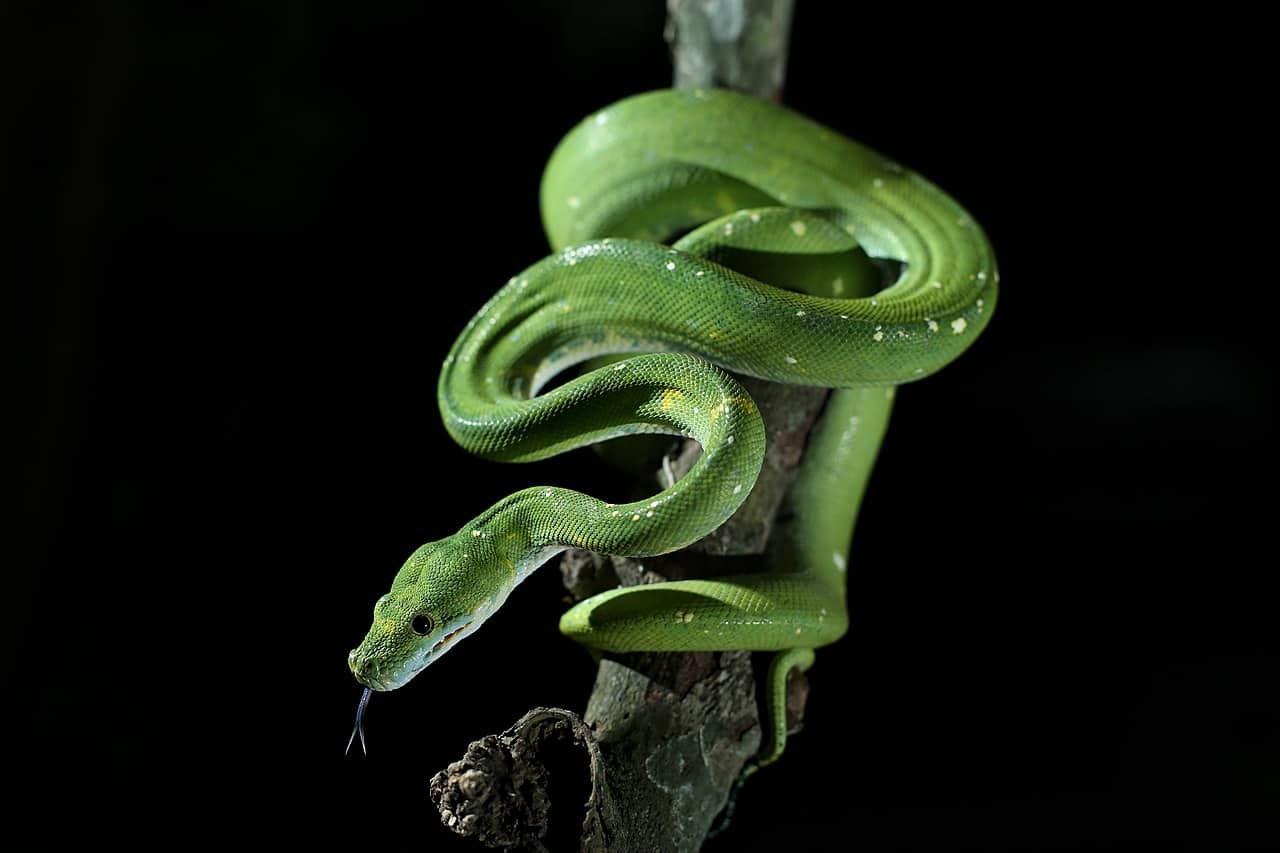
Some snakes, like the timber rattlesnake, stay the same colour throughout their lives. They pop out as a 20cm brown-beige venom noodle, and stay that colour for 15 years, only dramatically enlarged. But there are many snakes around the world whose colour changes subtly with age, and others which completely transform, often for mysterious reasons.
For example, the green tree python of Queensland is almost fully green to blend with its dense rainforest habitat, with occasional white patches, and a hungry snarling face. Yet as newborns, they’re a vivid banana yellow, with no trace of green. The first green appears at 12 months, in small speckles. Within 8 days, this can spread to every corner of their body, confining the yellow to mere memory.
Green tree pythons spend far more time on the forest floor as hatchlings, and this is theorised to be involved. Another species is the Arizona black rattlesnake, which lives in mountainous sky islands above 1000 metres. This species is almost completely black, with occasional white markings like stars or a door cracking open at night. At birth though, they look far more like a generic rattlesnake, with beige-black patterns.
| 2 | Banana blenders |
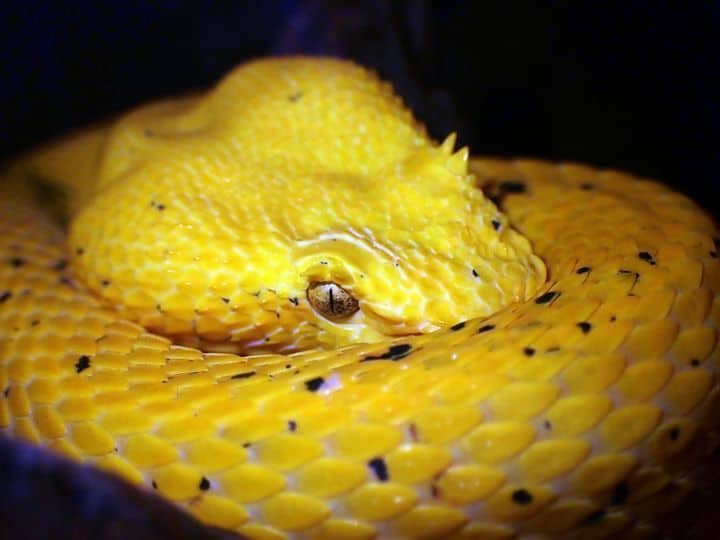
Impenetrable camouflage is widespread in the snake kingdom, but some take it further and adapt their patterns and colours to different locations, within the same species. For example, the eyelash viper has various unique morphs, but bright yellow ones are found in higher concentrations in banana plantations. This is in spite of the fact that banana plantations have only been created in the last 200 years, a nanosecond in evolutionary terms.
In mossy sections of forests, eyelash vipers tend to be rich green interspersed with red and grey. Various subspecies act similarly, such as the Sonoran coachwhip (Masticophis flagellum cingulum). This has pink scales to blend with local dry soils, as does the San Joaquin coachwhip.
But snakes don’t have to be full subspecies to metamorphasize and effortlessly blend in. They can have simple superficial morphs, like an overlay of paint. The rock rattlesnake stretches from Texas to Arizona. In western Texas (Davis mountains), they’re darker to blend with the region’s volcanic rock. But in eastern Texas (Stockton plateau), the soil is lighter, intermingled with limestone, and the local rock rattlesnakes are also lighter.
| 3 | Primitive leg remnants |
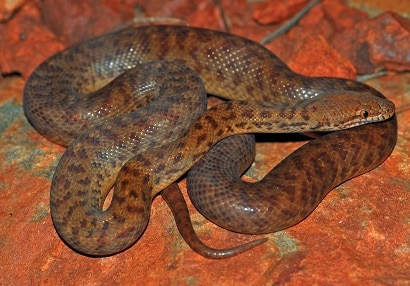
Snakes have been around for at least 100 million years (surviving the asteroid strike), yet some are far more evolved than others. Some are considered sleek and modern, like the Malaysian blue coral snake and its dazzling array of high-tech toxins. Others are primitive in skeletal structure, closer to the thick constrictors that first appeared in the late dinosaur (Cretaceous) period.
Boas and pythons are the most primitive snakes, and one feature they possess is pelvic spurs where their legs used to be. These are very small and pointed, and X-rays reveal that they’re still attached to their pelvis at the old location. These spurs are the last remains of limbs possessed by their reptile ancestors. In more evolved snakes like cobras, these have disappeared completely.
Species which have these vestigial limbs include pygmy pythons and ball pythons. Though not used for movement, these spurs aren’t completely superfluous. It’s theorised that male boas use them to grip females, or maybe give them a poke. They likely have at least one secret usage, or they wouldn’t have lasted so long. A reptile expert once found a pair of green tree pythons with unusually long remnant spurs, measuring 2-3cm. They were so long that the expert was worried they would interfere with locomotion.
| 4 | Thermal vision |
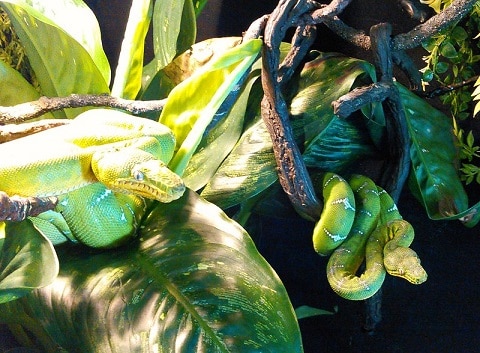
Another feature possessed by boas is heat-sensing pits, which give them infrared sensing abilities. Rattlesnakes also have these pits, and they allow snake to detect prey to extremely minute levels – when their body temperature is just 0.1 degree different to their surroundings. Not surprisingly, this makes them superior hunters.
These are called heat-sensing pits because they’re clearly visible along a snake’s face, particularly in hungry-looking constrictors like the emerald tree boa. This species may have the most advanced pit development of all. They have 20 on each side of the face, along with 2 regular eyes, leading to a classic internet claim that emerald tree boas have 42 eyes. Russell’s vipers are a weird one, as they possess IR sensing powers, yet the classic facial pits are missing.
After boas, vipers are the main family to have heat-sensing facial pits. In fact, the entire family is split in two along these lines. The Crotalinae group has them, including all rattlesnakes and Bothrops pitvipers. European vipers such as adders and asp vipers (Viperinae group) completely lack them. Most snakes with heat-seeking pits hunt endotherms, animals that generate their own body heat, including birds, but particularly mammals.
| 5 | Females dwarfing males |
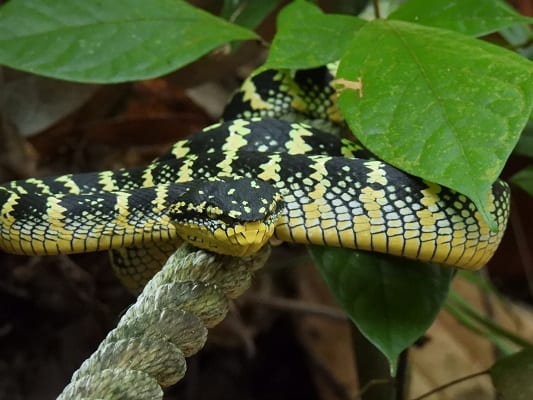
Female snakes are commonly larger than males, as they need to store the equivalent of 10-20 table tennis balls in their belly each year. However, a select few species take this to an extreme. Take the Wagler’s pitviper. A resident of southern Thailand and peninsular Malaysia, it’s also called the temple viper for hanging out near Azure Cloud temple, a tourist-infested Buddhist shrine. Female Wagler’s pitvipers can be 4 times heavier than males, and reach an average length of 100cm versus 75cm. Their colours are also wildly different – yellow-blue versus green for males, making it hard to even recognise them as the same species.
Over in the southern US, female brown watersnakes are so much larger than males that their meetings look absurd. Again, the females can be four times heavier, although this time their colours are similar (brown).
Because of eggs, it’s more common worldwide for females to outstrip males, but not the rule. Machete savane males are slightly longer than females, as are Tzabcan rattlesnakes. Wrestling has the closest correlation; species where males wrestle for dominance generally have longer males than females, one being the Australian mulga (the two above are also wrestlers).
| 6 | Snakes that look like things |
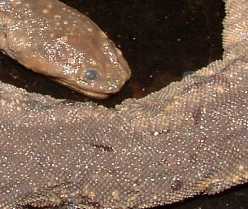
Sometimes, it’s advantageous for a snake to cease looking like a snake and start resembling random objects instead. Camouflage has several levels. First you become green, then you be green and lose all other patterns. Finally, you can become so long and thin that you resemble a swinging vine, and only the sharpest eyed eagle can distinguish you. This is what the Asian vine snake has achieved, a common species of Thailand and Vietnam.
Over in Indonesia, there’s bizarre sightings of elephant trunks floating in muddy estuaries, without being attached to their masters. Except that this is actually a very strange snake called Acrochordus javanicus, or the elephant trunk snake. This species is semi-aquatic and has evolved exceptionally baggy skin to keep it afloat in water. They measure up to 3 metres, and complete the elephant trunk picture with grey colours and hundreds of scales with tiny sensory spikes, which are exceptionally sensitive to fish movements.
In the deserts of Iran, in arid areas few visit, the spider-tailed viper goes about its daily duties. One of these is hiding behind rocks, and placing just its tail on the surface, luring in gredy birds. The reason this succeeds is that their tail is an almost exact match for an arachnid, using enlarged yet thin scales to represent its legs.
| 7 | Endless tongue variation |
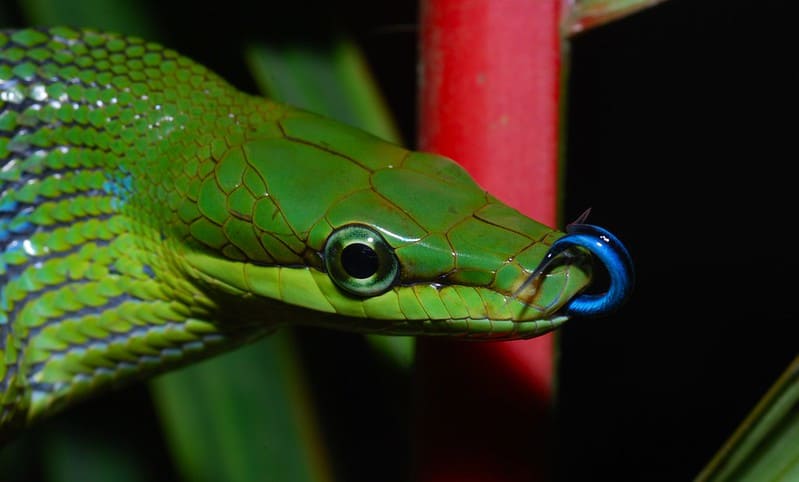
Tongue colour varies enormously in the snake kingdom. Some, like the painted bronzeback, have the usual fleshy red colour, but in Africa you have weird creatures like the marbled tree snake, which is split between white and black. The Pacific rattlesnake secretly has a purple tongue, while the red-tailed green ratsnake’s is streaked with blue, like they’ve been licking a lollypop with banned artificial flavourings. Snakes fleck their tongues so rapidly that it’s normally hard to make these colours out.
The exact reasons for the variations are unknown, though it’s partly skin deep. Silver morphs of the Asian vine snake also have a silver tongue, so varying pigments are clearly controlled by similar genes. However, garter snakes use the hunting technique of poking their tongue into a stream, wriggling it around for a while, and luring curious fish to the surface. A dull, fleshy pink tongue wouldn’t stand out enough – hence the bright redness with a black tip. There’s likely other secret explanations out there.
The same is true for eye colour. Snake eyes may be blue or green, but up close, no pair is truly the same in the immense details they possess.
| 8 | Ultra blackness (melanism) |
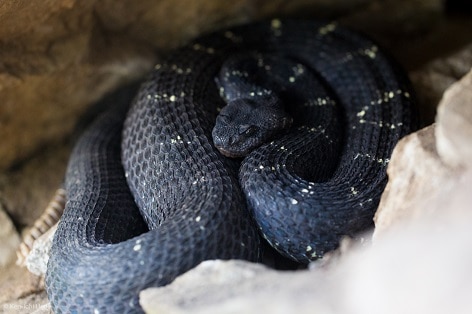
One reason why the Arizona black rattlesnake is so black is that they live at high altitudes, in mountainous pine-oak forests elevated far above the surrounding deserts (where beige tiger rattlesnakes live). Darker scales equals more melanin equals greater sunlight absorption.
Being dark is a particular advantage in mountainous environments, which are simultaneously cool and very sunny. This also happens within species which are ordinarily light. The UK and European adder is normally beige with a brown zig-zagging stripe down its back. But in high areas of the Austrian or Swiss alps, you can find melanistic populations where their scales are 100% jet black, destroying all patterns.
Sometimes, melanism happens due to random genetic luck. Jet black snakes can pop up anywhere, such as this melanistic Ussuri pitviper spotted on Jeju island, South Korea. This species is normally a traditional beige-brown. Extraordinarily yellow snakes are also possible. These are called xanthic individuals, and occur due to a massive overexpression of the genes responsible for xanthic (yellow) pigments. See this hyper yellow jararacussu in Brazil for an example.
| 9 | Bone shifting tactics |
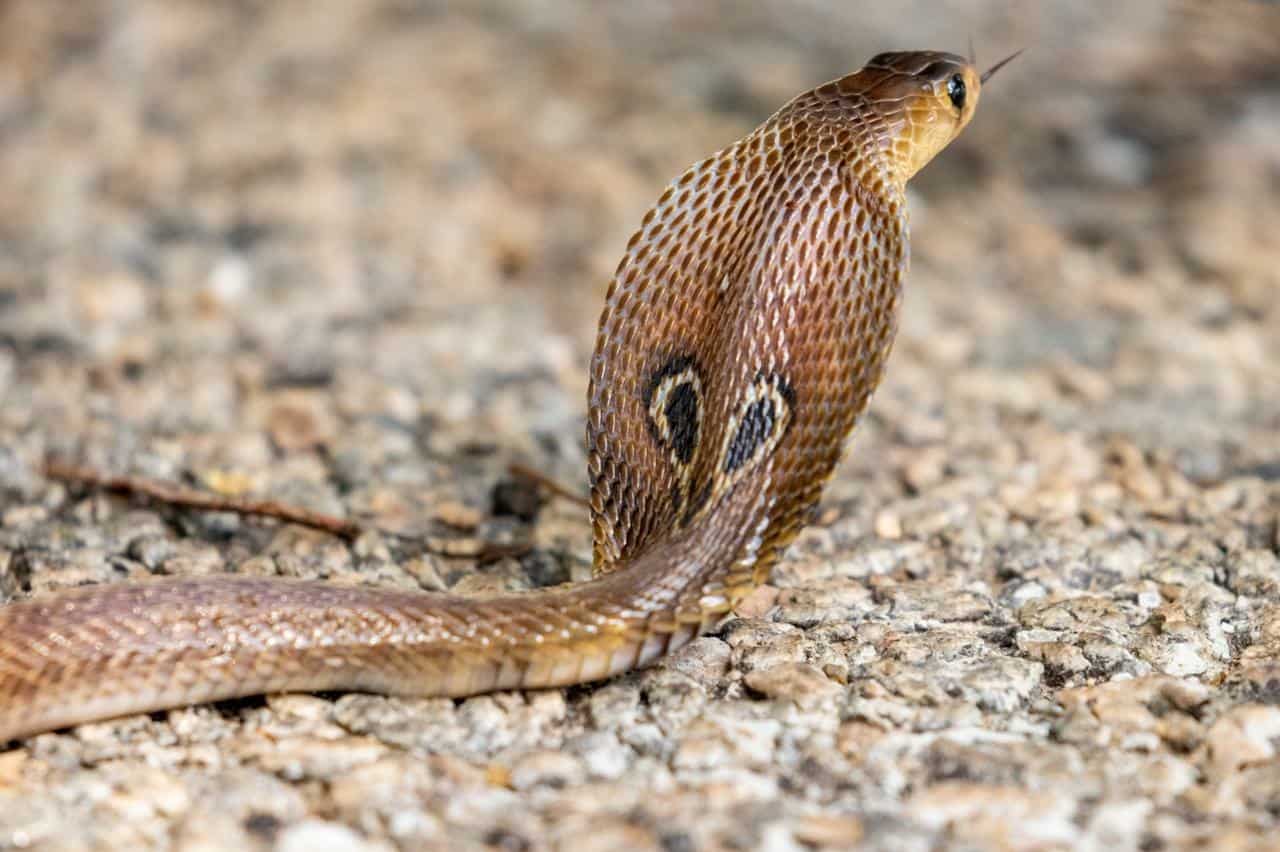
Imagine if you were confronted by armed muggers in an alleyway, and had the power to widen bones in your neck, making it look thicker and convincing enemies that you’re far more dangerous than you really are. No human possesses this power, but snakes do. A cobra’s flared hood is a widening of its ribcage, as they’re ordinarily as thin as any snake.
US hognose snakes can flatten their necks, though in a different style; pressing their bodies to the ground so that a bird witnesses the display from overhead. Snakes also metamorphize for strategic purposes, such as the northern watersnake. This river dweller of Ohio compresses its lower body while swimming, creating a more perfect tube which decreases water resistance, bringing their bodies closer to sea snakes.
Northern watersnakes can also shift warmth from their tail to their body, when autumn arrives and temperatures begin to cool. Another snake which widens its neck is the Angolan coral snake.
| 10 | Colourful neighbours |
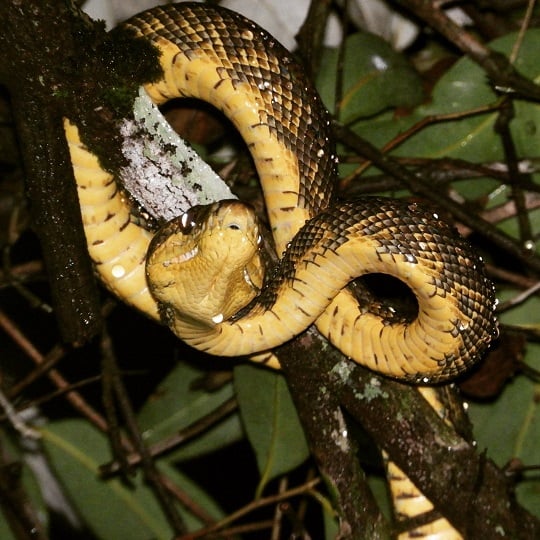
Some snakes are a boring monolith, with a single colour across a vast territory. This includes the large-eyed pitviper with its green shades, and the emerald tree boa with its green-white. Then you have snakes which are not only a kaleidoscope of colour, but somehow intermingle in the same neighbourhoods without diluting each other.
One is the eyelash viper mentioned at the beginning. This species has yellow, brown, stone and even a “Christmas” morph, which can all coexist in one dark forest hollow. The Amazon tree boa exists across a swathe of South America and has 3 main variants: grey (50%), orange (40%), and yellow (10%). These snakes commonly intermingle in a multi-coloured paradise. One Amazon tree boa was fully black, and after being bred with an orange morph in captivity, a new “tiger” breed was created.
It’s possible that for example, neon yellow members of a particular species are more attracted to other neon yellow members. Or perhaps yellow genes in the eyelash viper are so dominant that even if one carries green genetics, their influence will be silenced and no intermingling pattern will be created. One day, scientists will identify these specific genes.
